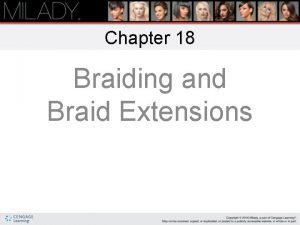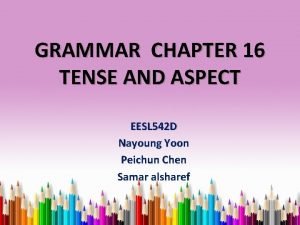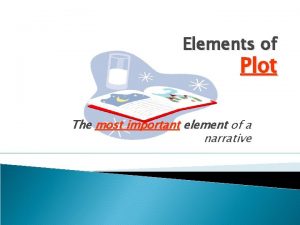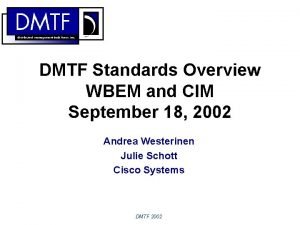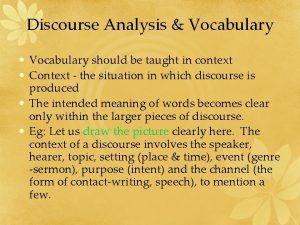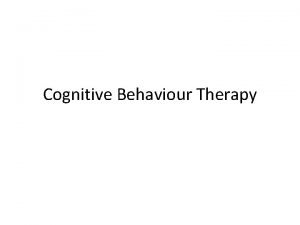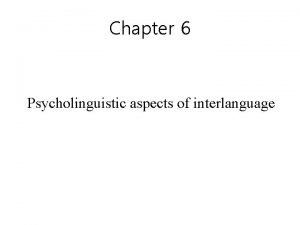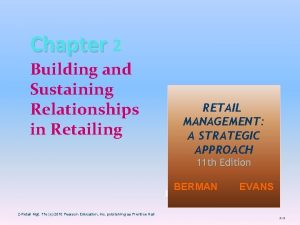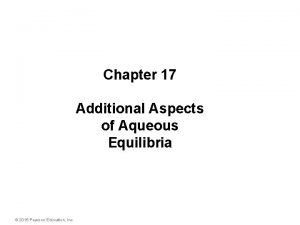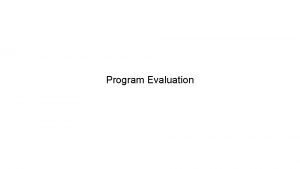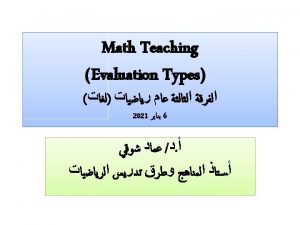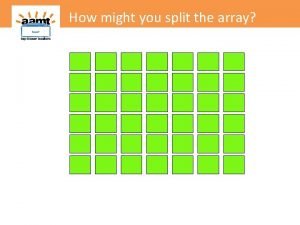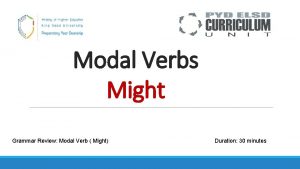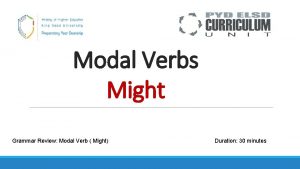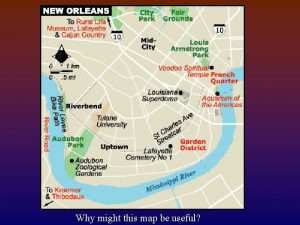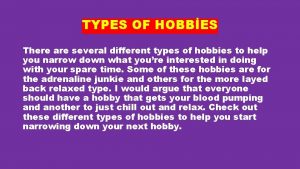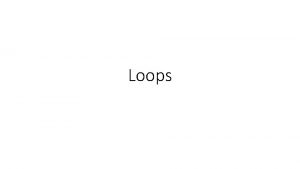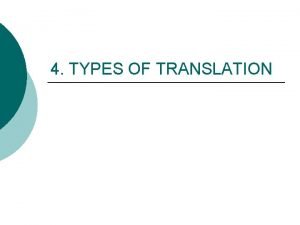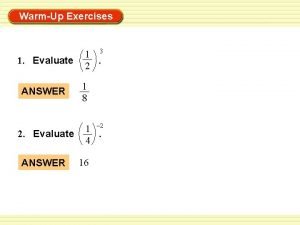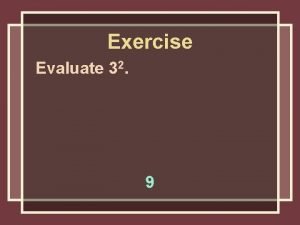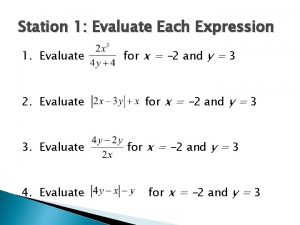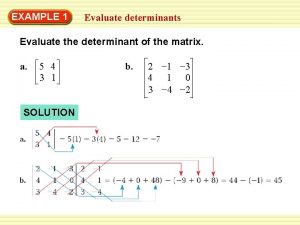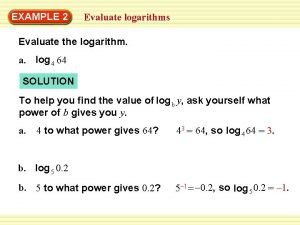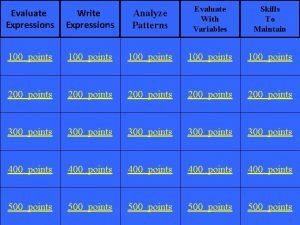Evaluation Types of Evaluation Might evaluate several aspects




































- Slides: 36

Evaluation

Types of Evaluation • Might evaluate several aspects – – – Assistance in formulating queries Speed of retrieval Resources required Presentation of documents Ability to find relevant documents • Evaluation generally comparative – System A vs. B – System A vs A´ • Most common evaluation - retrieval effectiveness Allan, Ballesteros, Croft, and/or Turtle

The Concept of Relevance • Relevance of a document D to a query Q is subjective – Different users will have different judgments – Same users may judge differently at different times – Degree of relevance of different documents may vary Allan, Ballesteros, Croft, and/or Turtle

The Concept of Relevance • In evaluating IR systems it is assumed that: – A subset of the documents of the database (DB) are relevant – A document is either relevant or not Allan, Ballesteros, Croft, and/or Turtle

Relevance • In a small collection - the relevance of each document can be checked • With real collections, never know full set of relevant documents • Any retrieval model includes an implicit definition of relevance – – Satisfiability of a FOL expression Distance P(Relevance|query, document) P(query|document) Allan, Ballesteros, Croft, and/or Turtle

Evaluation potato blight … growing potatoes … Potato farming and nutritional value of potatoes. x Mr. Potato Head … x nutritional info for spuds • Set of queries • Collection of documents (corpus) small collection, can. Which review all documents • • If Relevance judgements: documents are correct and x incorrect for each query • Not practical for large collections Any ideas about how we might approach collecting relevance judgments for very large collections? Allan, Ballesteros, Croft, and/or Turtle

Finding Relevant Documents • Pooling – – Retrieve documents using several automatic techniques Judge top n documents for each technique Relevant set is union Subset of true relevant set • Possible to estimate size of relevant set by sampling • When testing: – How should un-judged documents be treated? – How might this affect results? Allan, Ballesteros, Croft, and/or Turtle

Test Collections • To compare the performance of two techniques: – each technique used to evaluate same queries – results (set or ranked list) compared using metric – most common measures - precision and recall • Usually use multiple measures to get different views of performance • Usually test with multiple collections – – performance is collection dependent Allan, Ballesteros, Croft, and/or Turtle

Allan, Ballesteros, Croft, and/or Turtle

Evaluation Retrieved documents Rel&Ret documents Relevant documents Let retrieved = 100, relevant = 25, rel & ret = 10 Recall = 10/25 =. 40 Ability to return ALL relevant items. Retrieved Precision = 10/100 =. 10 Ability to return ONLY relevant items. Allan, Ballesteros, Croft, and/or Turtle

Precision and Recall • Precision and recall well-defined for sets • For ranked retrieval – Compute value at fixed recall points (e. g. precision at 20% recall) – Compute a P/R point for each relevant document, interpolate – Compute value at fixed rank cutoffs (e. g. precision at rank 20) Allan, Ballesteros, Croft, and/or Turtle

Average Precision for a Query • Often want a single-number effectiveness measure • Average precision is widely used in IR • Calculate by averaging precision when recall increases Allan, Ballesteros, Croft, and/or Turtle

Allan, Ballesteros, Croft, and/or Turtle

Allan, Ballesteros, Croft, and/or Turtle

Allan, Ballesteros, Croft, and/or Turtle

Averaging Across Queries • Hard to compare P/R graphs or tables for individual queries (too much data) – Need to average over many queries • Two main types of averaging – Micro-average - each relevant document is a point in the average (most common) – Macro-average - each query is a point in the average • Also done with average precision value – Average of many queries’ average precision values – Called mean average precision (MAP) • “Average average precision” sounds weird Allan, Ballesteros, Croft, and/or Turtle

Allan, Ballesteros, Croft, and/or Turtle

Allan, Ballesteros, Croft, and/or Turtle

Averaging and Interpolation • Interpolation – actual recall levels of individual queries are seldom equal to standard levels – interpolation estimates the best possible performance value between two known values • e. g. ) assume 3 relevant docs retrieved at ranks 4, 9, 20 • their precision at actual recall is. 25, . 22, and. 15 – On average, as recall increases, precision decreases Allan, Ballesteros, Croft, and/or Turtle

Averaging and Interpolation • Actual recall levels of individual queries are seldom equal to standard levels • Interpolated precision at the ith recall level, Ri, is the maximum precision at all points p such that Ri p Ri+1 – assume only 3 relevant docs retrieved at ranks 4, 9, 20 – their actual recall points are: . 33, . 67, and 1. 0 – their precision is. 25, . 22, and. 15 – what is interpolated precision at standard recall points? Recall level Interpolated Precision 0. 0, 0. 1, 0. 2, 0. 3 0. 4, 0. 5, 0. 6 0. 7, 0. 8, 0. 9, 1. 0 0. 25 0. 22 0. 15 Allan, Ballesteros, Croft, and/or Turtle

Interpolated Average Precision • Average precision at standard recall points • For a given query, compute P/R point for every relevant doc. • Interpolate precision at standard recall levels – 11 -pt is usually 100%, 90, 80, …, 10, 0% (yes, 0% recall) – 3 -pt is usually 75%, 50%, 25% • Average over all queries to get average precision at each recall level • Average interpolated recall levels to get single result – Called “interpolated average precision” • Not used much anymore; “mean average precision” more common • Values at specific interpolated points still commonly used Allan, Ballesteros, Croft, and/or Turtle

Micro-averaging: 1 Qry • Let, Rq = {d 3, d 5, d 9, d 25, d 39, d 44, d 56, d 71, d 89, d 123} • |Rq| = 10, no. of relevant docs for q • Ranking of retreived docs in the answer set of q: 1. d 123 (*) 6. d 9 (*) 11. d 38 2. d 84 7. d 511 12. d 48 3. d 56 (*) 8. d 129 13. d 250 4. d 6 9. d 187 14. d 113 5. d 8 10. d 25 (*) 15. d 3 (*) 10 % Recall=>. 1 * 10 rel docs = 1 rel doc retrieved One doc retrieved to get 1 rel doc: precision = 1/1 = 100% Find precision given total number of docs retrieved at given recall value. Allan, Ballesteros, Croft, and/or Turtle

Micro-averaging : 1 Qry • Let, Rq = {d 3, d 5, d 9, d 25, d 39, d 44, d 56, d 71, d 89, d 123} • |Rq| = 10, no. of relevant docs for q • Ranking of retreived docs in the answer set of q: 1. d 123 (*) 6. d 9 (*) 11. d 38 2. d 84 7. d 511 12. d 48 3. d 56 (*) 8. d 129 13. d 250 4. d 6 9. d 187 14. d 113 5. d 8 10. d 25 (*) 15. d 3 (*) 10 % Recall=>. 1 * 10 rel docs = 1 rel doc retrieved One doc retrieved to get 1 rel doc: precision = 1/1 = 100% 20% Recall: . 2 * 10 rel docs = 2 rel docs retrieved 3 docs retrieved to get 2 rel docs: precision = 2/3 = 0. 667 Find precision given total number of docs retrieved at given recall value. Allan, Ballesteros, Croft, and/or Turtle

Micro-averaging : 1 Qry • Let, Rq = {d 3, d 5, d 9, d 25, d 39, d 44, d 56, d 71, d 89, d 123} • |Rq| = 10, no. of relevant docs for q • Ranking of retreived docs in the answer set of q: 1. d 123 (*) 6. d 9 (*) 11. d 38 2. d 84 7. d 511 12. d 48 3. d 56 (*) 8. d 129 13. d 250 4. d 6 9. d 187 14. d 113 5. d 8 10. d 25 (*) 15. d 3 (*) 10 % Recall=>. 1 * 10 rel docs = 1 rel doc retrieved One doc retrieved to get 1 rel doc: precision = 1/1 = 100% 20% Recall: . 2 * 10 rel docs = 2 rel docs retrieved 3 docs retrieved to get 2 rel docs: precision = 2/3 = 0. 667 30% Recall: . 3 * 10 rel docs = 3 rel docs retrieved 6 docs retrieved to get 3 rel docs: precision = 3/6 = 0. 5 What is precision at recall values from 40 -100%? Allan, Ballesteros, Croft, and/or Turtle

• |Rq| = 10, no. of relevant docs for q • Ranking of retreived docs in the answer set of q: 5. d 8 9. d 187 13. d 250 2. d 84 6. d 9 (*) 10. d 25 (*) 14. d 113 3. d 56 (*) 7. d 511 11. d 38 15. d 3 (*) 4. d 6 8. d 129 12. d 48 Precision 1/1 = 100% 2/3 = 0. 67% 3/6 = 0. 5% 4/10 = 0. 4% 5/15 = 0. 33% 0% … 0% 120 100 Precision Recall 0. 1 0. 2 0. 3 0. 4 0. 5 0. 6 … 1. 0 1. d 123 (*) 80 60 Recall/ Precision Curve • • • 40 • • 20 0 20 40 • • 60 • • 80 • 100 • Recall 120 Allan, Ballesteros, Croft, and/or Turtle

Averaging and Interpolation • macroaverage - each query is a point in the avg – can be independent of any parameter – average of precision values across several queries at standard recall levels e. g. ) assume 3 relevant docs retrieved at ranks 4, 9, 20 – their actual recall points are: . 33, . 67, and 1. 0 (why? ) – their precision is. 25, . 22, and. 15 (why? ) • Average over all relevant docs – rewards systems that retrieve relevant docs at the top (. 25+. 22+. 15)/3= 0. 21 Allan, Ballesteros, Croft, and/or Turtle

Recall-Precision Tables & Graphs Allan, Ballesteros, Croft, and/or Turtle

Document Level Averages • Precision after a given number of docs retrieved – e. g. ) 5, 10, 15, 20, 30, 100, 200, 500, & 1000 documents • Reflects the actual system performance as a user might see it • Each precision avg is computed by summing precisions at the specified doc cut-off and dividing by the number of queries – e. g. average precision for all queries at the point where n docs have been retrieved Allan, Ballesteros, Croft, and/or Turtle

R-Precision • Precision after R documents are retrieved – R = number of relevant docs for the query • Average R-Precision – mean of the R-Precisions across all queries e. g. ) Assume 2 qrys having 50 & 10 relevant docs; system retrieves 17 and 7 relevant docs in the top 50 and 10 documents retrieved, respectively Allan, Ballesteros, Croft, and/or Turtle

Evaluation • Recall-Precision value pairs may co-vary in ways that are hard to understand • Would like to find composite measures – A single number measure of effectiveness • primarily ad hoc and not theoretically justifiable • Some attempt to invent measures that combine parts of the contingency table into a single number measure Allan, Ballesteros, Croft, and/or Turtle

Contingency Table Miss = C/(A+C) Allan, Ballesteros, Croft, and/or Turtle

Symmetric Difference A is the retrieved set of documents B is the relevant set of documents A B (the symmetric difference) is the shaded area Allan, Ballesteros, Croft, and/or Turtle

E measure (van Rijsbergen) • used to emphasize precision or recall – like a weighted average of precision and recall • large a increases importance of precision – can transform by a = 1/(b 2 +1), b = P/R – when a = 1/2, b = 1; precision and recall are equally important E= normalized symmetric difference of retrieved and relevant sets E b=1 = |A B|/(|A| + |B|) • F =1 - E is typical (good results mean larger values of F) Allan, Ballesteros, Croft, and/or Turtle

Expected Search Length • Evaluation is based on type of information need e. g. ) 1. 2. 3. 4. • • only one relevant document required some arbitrary number n all relevant documents a given proportion of relevant documents…. . Search strategy output assumed to be weak ordering Simple ordering means never have two or more documents at the same level of the ordering Search length in a simple ordering is the number of nonrelevant documents a user must scan before the information need is satisfied Expected search length appropriate for weak ordering Allan, Ballesteros, Croft, and/or Turtle

Expected Search Length Allan, Ballesteros, Croft, and/or Turtle

Other Single-Valued Measures • Breakeven point – point at which precision = recall • Swets model – use statistical decision theory to express recall, precision, and fallout in terms of conditional probabilities • Utility measures – assign costs to each cell in the contingency table – sum (or average) costs for all queries • Many others. . . Allan, Ballesteros, Croft, and/or Turtle
 It encompasses several different aspects, including
It encompasses several different aspects, including Preparing textured hair for braiding
Preparing textured hair for braiding 6 aspects of wellness
6 aspects of wellness Chapter 18 visual merchandising and display
Chapter 18 visual merchandising and display Trade related aspects of intellectual property rights
Trade related aspects of intellectual property rights From slavery through reconstruction
From slavery through reconstruction 5 themes of geography chart
5 themes of geography chart All aspects of software production
All aspects of software production Alterations in various aspects of society over time
Alterations in various aspects of society over time Consciuosly
Consciuosly Cultural aspects
Cultural aspects Example of regression defense mechanism
Example of regression defense mechanism Legal aspects of catering premises
Legal aspects of catering premises Abstraction-occurrence design pattern
Abstraction-occurrence design pattern Features of romanticism
Features of romanticism Look at the photos. answer the questions
Look at the photos. answer the questions Mario full screen
Mario full screen بنية النص الوصفي
بنية النص الوصفي Verb aspects
Verb aspects Quantitative chemistry grade 11
Quantitative chemistry grade 11 Factual inquiry in ethics
Factual inquiry in ethics Abstract forms and shapes on a bare stage
Abstract forms and shapes on a bare stage Why is plot the most important element
Why is plot the most important element Factual elements
Factual elements Economic aspects of marriage
Economic aspects of marriage Legal aspects of doing business in canada
Legal aspects of doing business in canada Dmtf cim
Dmtf cim Vocabulary and organizing of text
Vocabulary and organizing of text Discourse organizing words
Discourse organizing words Quality of a person
Quality of a person Health aspects of family planning
Health aspects of family planning Padesky 5 aspects
Padesky 5 aspects Creative aspects of advertising
Creative aspects of advertising Psychological aspects of interlanguage
Psychological aspects of interlanguage Chapter 3 legal and ethical aspects of nursing
Chapter 3 legal and ethical aspects of nursing Value-oriented retail strategy
Value-oriented retail strategy Additional aspects of aqueous equilibria
Additional aspects of aqueous equilibria

